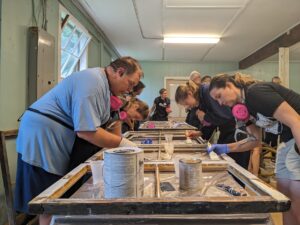
To demolish or not to demolish? That is the question…
- August 19, 2008
- 1:27 pm
- August 19, 2008
- 1:27 pm
I have only lived in Rochester for about a year. One of the big things that was happening when I get to town was the demolition of a number of Kodak buildings. I watched from the comfort of my couch, not really knowing my way around town and not really having a special affinity for the buildings that would drive me to want to see it in person.
I had, and still have, a lot of mixed feelings about these demolitions. History was made there. This is an internationally important company. Those buildings were a big part of that story, were from the heyday of the company, on and on. Were they beautiful? I’m not sure, I didn’t really get to see them. Does it matter? Not so much.
On the other hand how, where, when would these buildings ever be rehabilitated, ever be needed again? Because of their scale and their location in a less then thriving economy it would take a miracle for them to be reused. Should they be allowed to sit vacant, deteriorating and becoming a part of the urban blight of the city because of their history?
Right now at Rochester Contemporary there is an exhibition on the State of the City. One display in this exhibition is photographs of Kodak buildings throughout the world in various states of demolition and deconstruction. Robert Burley, the artist, has stated that these buildings were often not just buildings, a shell, but were in essence gigantic machines were it would be impossible to extricate the processing equipment without dismantling the entire building. And that the nature of the equipment, for manufacture of film, was not likely to ever be needed or used again given the shift to digital formats over 35 mm film. This makes these buildings very different from, say, an old carriage of box manufacturing facility that could be rehabbed as housing, offices or retail.
While Rochester is still relatively new to me, the problem of the vacant Kodak buildings are not. I am, as I have probably written about 800 times, originally from Binghamton…Endwell specifically for those that know Broome County. Just a few miles from where I grew up is Endicott, NY – the birth place of IBM and a huge district of the attendant office space, cafeterias, manufacturing facilities, etc. The majority of which are now currently vacant and not likely to be reused. If Rochester’s economy is kind of tough, Binghamton/Broome County’s is on life support. While these buildings are of a scale where they could be more easily rehabbed then the Kodak buildings the economy simply does not need them. Right down the street from this complex is the graveyard of what used to by Endicott Johnson, a shoe manufacturer. These buildings are beyond derelict, with most windows smashed and nature reclaiming the space foot by foot. Should the IBM buildings be demolished or designated? (Not that one necessarily precludes the other). Again, this is a company that went on to have a long term international impact and this where it all began.
The bright side? Is there one? Last year my brother got married at the McKinley in Endicott – the former IBM corporate cafeteria now a little more dressed up as an events facility.


This is a fantastic recent past resource, a marvel of modern architecture. It was a great night and a great example of what can happen with a building that has to find a new use. So, are we throwing some of these building away needlessly? Do they just need a little more time, need to find someone with enough imagination and the right business model? Or, are we doing the right thing by demolishing them before they become a blight? Which is the greater detriment to our urban character?
No answers here. Anyone else?
posted by Rebecca Rowe, Preservation Program Coordinator for The Landmark Society.
SHARE




